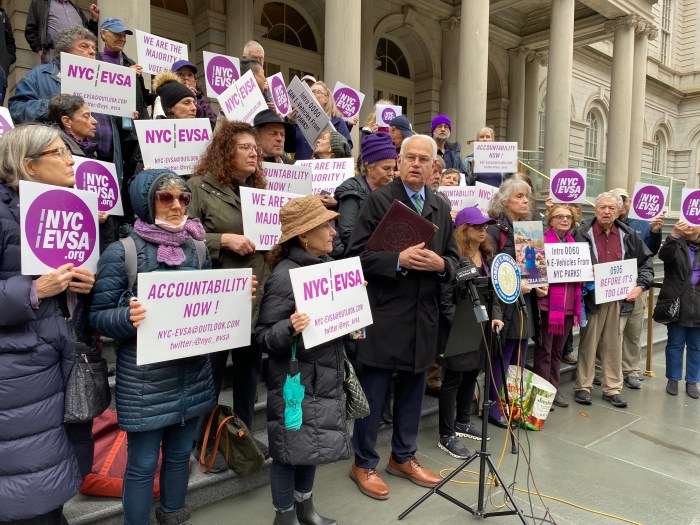
City cyclists are now legally allowed to ride through red lights at certain intersections under a new pilot from the Department of Transportation aimed at increasing safety.
At 50 intersections spread through Manhattan, Brooklyn and Queens, bike riders can now follow pedestrian signals instead of traffic lights. The idea is to give cyclists the same benefits pedestrians at the intersections get: a head start crossing the street, bringing added visibility.
The pilot of the policy, in effect Tuesday, is already used in some other municipalities, like Washington, D.C. It takes advantage of new signaling practices the DOT has begun relying on more heavily in recent years called Leading Pedestrian Intervals, or LPIs. The intervals hold red lights for traffic in each direction between seven and 11 seconds to give pedestrians crossing some time free of conflict from turning vehicles.
The city has installed 2,547 LPIs through its roughly 13,000 signalized intersections around the city, with the vast majority of those implemented through Mayor Bill de Blasio’s Vision Zero initiative that launched in 2014.
And here’s the list of the 50 intersections selected for the pilot. pic.twitter.com/irEQazv2j2
— Vincent Barone (@vinbarone) March 27, 2018
Intersections are particularly dangerous for cyclists, accounting for the location of 65 percent of rider deaths and 89 percent of injuries, according to a city report last year.
“We have seen how LPIs save lives, playing a significant role in New York City’s historic 32 percent drop in pedestrian deaths last year. Cycling safety has also improved considerably, but there is still progress to be made,” said Sean Quinn, the DOT’s senior director of Bicycle and Pedestrian programs, at a Boerum Hill news conference announcing the pilot. “With this pilot, we hope to learn if LPIs can provide those same safety benefits to cyclists.”
Each selected crossing will be marked with new signage announcing the rule change. And turning cyclists will still be required to yield to pedestrians.
Quinn said locations were picked based on safety data, with dangerous intersections taking priority. The city will study the pilot through October before contemplating a citywide expansion — even though the city is essentially playing catch up to the many cyclists who already follow the policy illegally, riders pointed out.
“When I told people that it was happening . . . people said, ‘Wait a minute; that’s not already legal?,’ ” said Brooklyn resident and advocate Doug Gordon. “It’s common practice. People just do it without actually knowing the legality of it. They do it because they know it keeps them safe. So this is just a common -sense thing that is coming from watching behavior and understanding that bicycles are different than cars.”
By using signage for a pilot, Quinn said that the city did not need to change traffic laws in order to implement the policy, but a citywide rollout could require legislation.
Brooklyn Councilman and frequent cyclist Carlos Menchaca had first proposed the policy through a bill he introduced in 2016. But the bill languished due to concerns from the police Ddepartment, he said, adding that he was “confident” that the pilot would lead to a change in law.
“Safety was the one thing that brought us all to the table, no doubt. But I think NYPD, before they make these kind of holistic citywide changes, need data,” Menchaca said. “And that’s not data that we were able to present because there was no study. So we finally went back to the concept of study. It’s going to slow this down, but it at least gives us the opportunity to grow other initiatives out of this data as well.”
Pilot locations
Many of the locations selected are along Ninth and Second avenues in Manhattan, at certain intersections between 20th and 55th streets. The city also picked several intersections along Fourth Avenue in Brooklyn between 18th and 63rd streets. And in Queens, the pilot focuses on Roosevelt Avenue, at 10 intersections between 51st and 83rd streets.



































